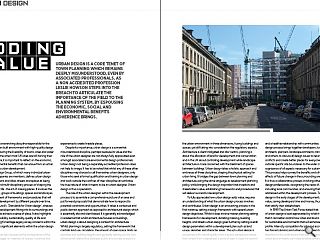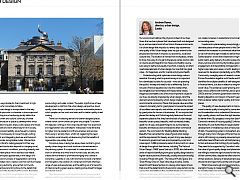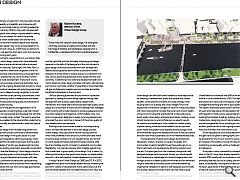Urban Design: Adding Value
19 Jan 2023
Urban design is a core tenet of town planning which remains deeply misunderstood, even by associated professionals. As a non accredited profession Leslie Howson steps into the breach to articulate the importance of the field to the planning system, by espousing the economic, social and environmental benefits adherence brings.
Urban design is the overarching discipline responsible for the creation of the urban built environment with high-quality design being central to ensuring the liveability of towns, cities and wider urban areas. At a time when most UK cities are still honing their visions for the future, it is important to reflect on the economic, social and environmental benefits that can ensue from an urban design approach to urban development. The Urban Design Group, of which many individual urban designers and companies are members, defines urban design as the design of towns and cities, streets and spaces as being the collaborative and multi-disciplinary process of shaping the physical setting for life - the art of making places.
It involves the design of buildings, groups of buildings, spaces and landscapes, and the establishment of frameworks and procedures that will deliver successful development by different people over time. Edinburgh City Council’s `Standards for Urban design`, stresses the importance of development fitting into its surroundings and the wider context, to achieve a sense of place. It also highlights public safety, accessibility, sustainability, quality of life and protecting Edinburgh’s heritage legacy as key concerns within the public realm and as significant elements within the urban design agenda.
Urban design can also be seen as the orchestration of the built urban environment; an interplay of spaces, buildings and other elements, combining as a rich emotional and legible experience to create liveable places. Despite its importance, urban design is a somewhat misunderstood discipline, perhaps because its value and the role of the urban designer are not always fully appreciated even amongst associated core environmental design professionals. Urban design not being a separately accredited profession does not help its image. It has to be noted that whilst any of these other disciplines may choose to call themselves urban designers, only those who seek a formal qualification and training in urban design and work outside the confines of their discipline can embrace the true nature of what it means to be an urban designer. Urban design is thus a specialism.
The role of the urban designer within the development process is to assemble a comprehensive picture of an area and put forward proposals that demonstrate how to respond to potential constraints and opportunities. It takes a contextual and public domain approach as opposed to architectural design which is essentially site and client based. It is generally acknowledged in academia that whilst architecture focuses on buildings, urban design is about designing a context for architecture. Whilst planning is largely regulatory, setting the framework that controls land use, circulation, the amount of open space, limits on densities and building heights and generally setting out the two-dimensional relationship between public and private spaces it is not a design discipline as such.
Urban design is just that, designing the urban environment in three dimensions, fusing buildings and spaces, yet still taking into consideration the regulatory aspects. Architecture is client-instigated and site–centric, planning is about the allocation of land for development and conservation and in the UK about controlling development while landscape architecture is more concerned with the treatment of spaces between buildings. Urban design takes a holistic approach and embraces all three disciplines, shaping the physical setting for urban living. It bridges the gap between town planning and architecture using the same language as development planning policy, while bringing the design inspiration that investors and stakeholders value, establishing frameworks and procedures that will deliver successful development. To fully appreciate how urban design adds value, requires an understanding of what the urban design process involves and contributes. Urban design is an envisioning process in the first instance, setting a design framework with several urban design objectives. Whilst it does involve master planning setting frameworks for development, dictating massing, building heights, and streets urban design goes further by setting overall design parameters within a development plan such as land usage, densities and character areas.
Though urban design is concerned with overall quality from a public perspective rather than simply from a developer`s point of view; it does not restrict development and can lead to better outcomes for the developers and a healthier relationship with communities. The urban design process brings together developers, local communities, architects, planners, landscape architects, transport engineers and others, to discuss all design issues to resolve problems and conflicts and create better places for everyone. It involves thinking outside specific site boundaries to the wider context and to take cognizance of all aspects necessary for sustainable place-making. This process helps convey the benefits and other ripple-out effects of future change in the surrounding area to other parties. It is thus a collaborative process involving other environmental design professionals, recognising the views of all stakeholders including local communities, and ensuring that key issues are addressed within the development process.
Time spent on urban design in the early stages of the development process can add value, saving developers time and money, thus achieving results that satisfy their stakeholders. In 1999 The Urban Task Force stated that: `The importance of urban design is best appreciated by what it can achieve` and that it can better control how cities and towns grow and make for sustainable environments that will enhance a city’s economic profile. Inter-city competition for jobs and economic activities has forced planning and urban policymakers to pay greater attention to the contribution that well-designed and managed urban environments can make towards enhancing the economic competitiveness of places. Thus, if it can be demonstrated that good urban design pays dividends, then investment in high-quality design will be far more likely to follow.
Good quality urban design is encapsulated in the very objectives it seeks to promote, i.e character in townscape and landscape, responding to and reinforcing locally distinctive patterns of development and culture, continuity of street frontages and the enclosure of space by development which clearly defines private and public areas, public spaces and routes that are attractive, safe and work effectively for all in society. Accessibility and local permeability are achieved by making places that connect and are easy to move through, putting people before traffic and integrating land use and transport. Legibility which provides recognizable routes, intersections and landmarks are critical to helping people find their way around. Development should also respond to changing social, technological and economic conditions, providing diversity and working to create viable places which address local needs. Urban design principles applied early in the design of a development proposal or process of regeneration can bring together a well-founded vision, create a common set of principles with the local planning authority, ensure that community views are well understood and bring focus to the details that will ultimately matter in the development’s success.
Examples of good urban design are most recognizable in the cities and places that people feel comfortable in, places which have distinctive identities combined with built forms which fit into their surroundings and wider context. The public significance of new development is vital from the urban design perspective. Good quality urban design is essential to produce sustainable places in which people can live, work and relax and for better quality street making. There is an increasing demand for better-designed places where vibrant communities can grow and prosper. To achieve this requires a change in how cities are planned, how expansion and regeneration are controlled to make areas more attractive to higher income residents and the businesses and services that supply or employ them, whilst not neglecting the need to maintain social diversity while ensuring that the benefits of regeneration are widely shared. Conscious place-making has always been central to good-quality urban design and must continue to be embedded in the planning system. It is important to create places which work on all levels and which are of human scale, are safe, and create distinctiveness to promote belonging and a sense of ownership.
Legibility is vital, with landmarks to assist orientation and navigation, the creation of a varied environment offering a range of uses and experiences and the setting out of a hierarchy of interconnecting green spaces, creating active street frontages and vibrant spaces. New development must respond to existing development patterns, reinforcing existing local character and identity as well as integrating new and existing development at their boundaries, maintaining the continuity of urban form. Structure plans should demonstrate permeability and legibility and coherence with clear block definition and street-making, promoting pedestrian movement and connectivity. Whilst in the public development sector the value of good urban design is appreciated for adding long-term value, this is not always the case in the private development sector where stakeholders with shorter time horizons may tend to see that increased capital costs required to achieve good urban design may not be compensated for by the increases in short term value.
So, whilst there are barriers to good urban design, not least the short-term costs, this has to be balanced against the long-term gains. Some of the most highly valued districts in our historic cities demonstrate good urban design; areas which have delivered good investment returns and an attractive built environment over decades or even centuries. Edinburgh’s own New Town, a forward-thinking initiative to relieve the congestion of the Old Town, is one such example; classical planning using a geometric structuring process enables the city council to effect control over follow-on large-scale development. There are of course numerous more recent examples where local authorities have retained control over the ongoing development process or where development corporations have been set up by the government, such as Milton Keynes, to relieve housing congestion in London.
These examples prove that urban planning outcomes are, in the long term, most satisfactory within a development plan based on urban design principles prescribing quality and character of development, especially housing. Nowadays, much of the growth and regeneration of UK towns and cities especially concerning large-scale high-impact development tends to be piecemeal and developer-led with little consideration for the wider urban context. The result is assertive modern architecture unrelated to the site and often undermining the character of the locality and detrimental to cities with special architectural qualities.
The role of urban design within the planning system and in the urban development process cannot be underestimated; promoting good urban design in the public sector is crucial and extends far beyond regulatory planning processes. Urban design should be central to the planning process and the public sector both in the design of wholly new developments but also developments within existing urban fabric especially conservation areas and heritage cities like Edinburgh. Urban design should be embedded in the planning system and be thought about from the start of the planning and development process with clear development plans, promotion of place plans, good planning guidance and development control processes within the planning system which are robust and such as to encourage good design, everywhere in the urban domain.
The DETR in their document `Urban design in the planning system: towards better practice`, states that: `Using the planning system effectively to create the conditions for better urban design requires positive management planning, meaningful collaboration and the right skills and that ultimately, achieving good design depends on the skills of the designer and the commitment to good design of all those concerned with new development. Better practice guidance alone cannot substitute for skilled designers and their ability to analyse places, to understand how they can be used and experienced and to design with flair and sensitivity’. Establishing more extensive development plans and visions based on urban design principles and tied in with planning permissions in principle, whether of greenfield or brownfield sites, will give confidence to investors and communities and will be beneficial to developers in the long term. All local planning authorities should strive for a proactive approach by setting the urban design agenda through clear development plan policies, supported by design briefs, frameworks and master plans and should seek high-quality urban design as a component of their economic development strategies whilst working with private interests to achieve agreed economic and urban development objectives. Unfortunately, many now lack in-house urban designers to assess incoming development proposals thus poor outcomes in respect of the urban quality of new developments are inevitable.
Building urban communities as well as nurturing existing ones is an important element in the urban design process. Unfortunately, many speculative volume housing schemes which now proliferate in and around our towns and cities whilst providing large numbers of much-needed homes are not built on urban design principles, lack distinctiveness of place, offer few if any facilities and do not result in sustainable communities. Regrettably, commercial pressures often mitigate against long-term investment in good-quality urban design. Only, it seems, by offering solid evidence that good urban design can deliver better economic value will sceptical-minded developers be convinced.
A study Value of Urban Design by CABE and DTLR in 2002, suggested that good urban design added value by increasing the economic viability of development and by delivering social and environmental benefits and concluded that economic value was measurable by tangible financial benefits; raising the prestige of place, opening up investment opportunities, producing high returns on investments, increased land values and reduced long term maintenance costs. It has been proven that good quality urban design can offer both direct benefits to those responsible for investing in development, public and private, and indirect benefits, social and environmental, to society at large. In the housing sector, for example, the Urban Villages Forum has argued that conventional concepts of value for money associated with mass housing fail to consider the social costs of poor health, crime and commuting that eventually fall on the public purse. Good quality urban design enhances land values, creating a more vibrant local economy and confidence in an area for would-be investors and developers. It also makes for a better quality of place-making, enhances social benefits such as improved public health and greater social equality and encourages more environmentally supportive development such as reduced vehicle emissions and more sustainable use of non-renewable resources.
The beneficiaries of good urban design are landowners, developers, funders, investors, occupiers, the public and communities. Investors benefit through favourable returns on their investments and developers by attracting investors and pre-lets. Occupiers gain from the increased prestige that well-designed developments command. Society as a whole benefit from the economic advantages of successful regeneration and through access to a better-quality environment and an enhanced range of amenities and facilities, public authorities benefit by meeting their obligation to deliver a well-designed, economically and socially viable environment which can then have a ripple effect on adjoining areas. There are many challenges which will determine town and city planning in the future; the effects of climate change, how land is used, achieving social equality and the energy crisis. The United Nations has forecast that 68% of the world’s inhabitants will live in urban settlements by 2025.
This rapid population shift puts pressure on resources and requires a high level of urban management planning and with-it good quality urban design. The need to drastically reduce carbon emissions within the next 25 years and make places climate resilient will require planning with regards to infrastructure, appropriate land use planning, building flood resilient buildings, building urban ecosystems into master plans, designing around natural waterways and water courses and generally future-proofing as much as possible. In addition, pressures due to the ongoing increased cost of energy resources will affect how and what to build. Social inequality has to be eradicated within urban areas and thought has to be given to demographics and the type of housing we build and for which socio-economic groups especially, given an increase in the wealthy moving into cities which means maintaining social equality will be a challenge for urban planners and designers.
A long-term vision is essential for successful towns and cities. In the UK, many have already devised their particular vision towards 2050 usually with an emphasis on urban liveability and prioritizing features such as air quality, provision of open green space, social equality, housing and infrastructure provision. However, equal levels of attention must be given to the quality of the built urban environment, to urban growth management planning and to understanding the value that good urban design can bring to the quality of urban living. Many of these urban challenges will require innovation and a re-assessment of our urban landscape.
|
|





